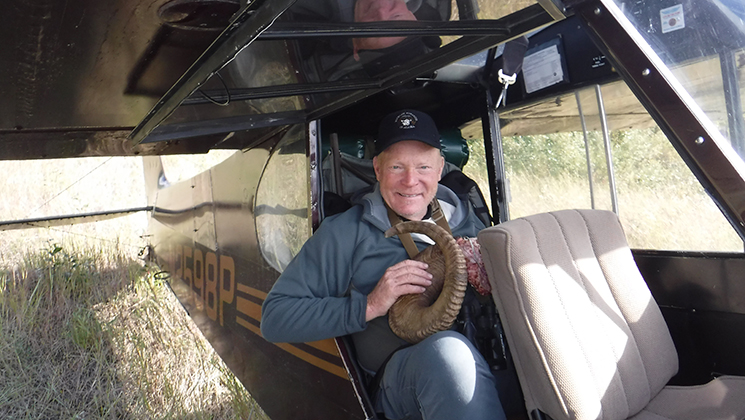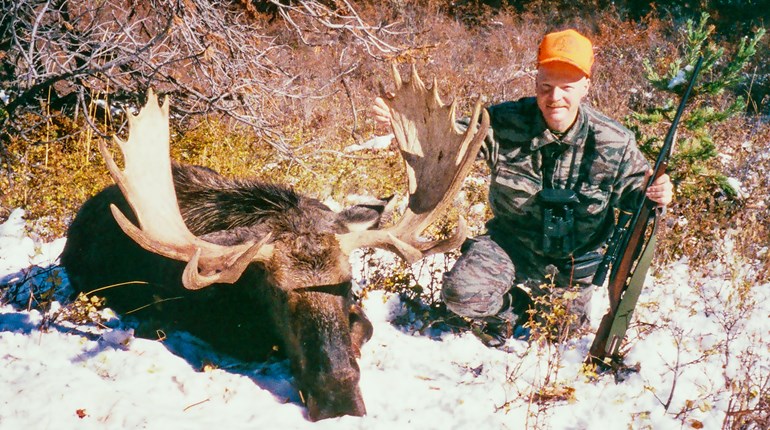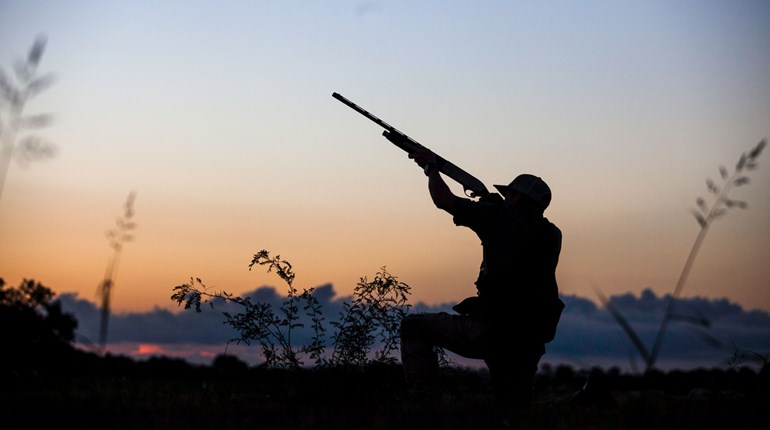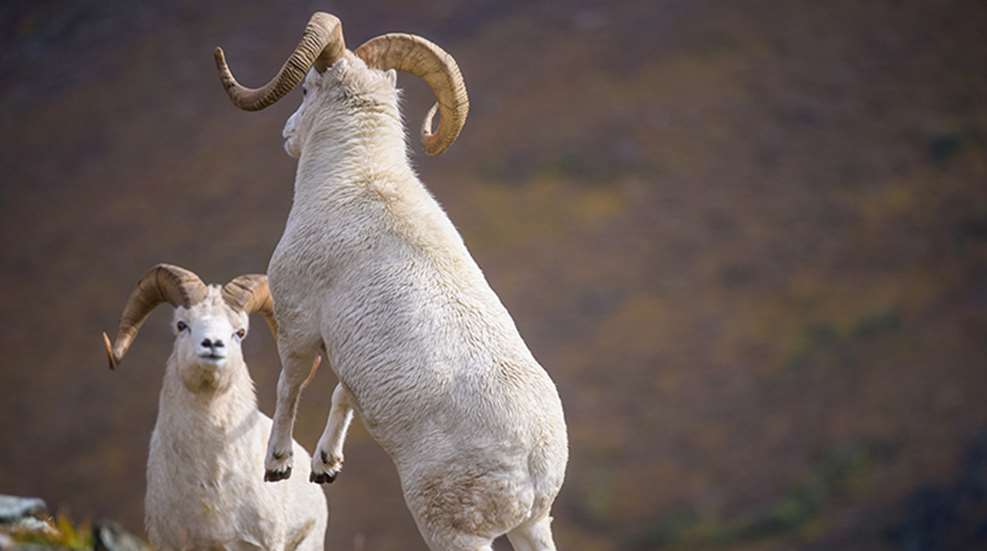
Our little cluster of backpack tents lay on a flat bench right at timberline. Slanting rimrocks offered protection if the wind came up, and the southern outcropping gave us a fine perch to glass up the left-hand valley. It ended in a grassy saddle below a big mountain, and in the late afternoon of the third day three rams fed slowly across it.
They were more than a mile away, glistening like cue balls on a pool table. The spotting scope brought them in: One was a half-curl. The second appeared to be a full-curl but tight and shallow, legal but small. The third looked … interesting, broomed on his left side and perfect on the right, not a monster but a mature ram with character.
At the moment there was nothing to be done; we’d be exposed if we moved. We kept watch while they slowly worked their way from right to left, eventually vanishing behind the left-hand ridge. Then we skedaddled. By now it was 6 o’clock, but in Arctic August we still had five hours of good light. I figured two hours would get us to the saddle. (That would prove to be about right, but as usual, the climb was worse than it looked.)
Not knowing where the rams had gone, we went up the far end of the steep left-hand ridge. The saddle was empty. Around the corner it dropped into an enticing bowl so we kept climbing and spotted our cue balls feeding happily on the far rim of the bowl. At this point they were 800 yards away and the wind was howling.
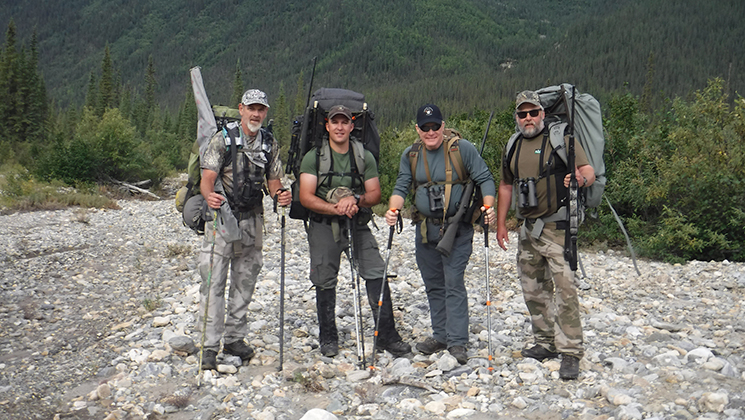
Sunset Standoff
We were four: me, guide Jordan Wallace, packer Dillon Judd and David Dressler. As an Alaska resident, David guides for our outfitter Dave Leonard’s Mountain Monarchs of Alaska—except on this trip he was there to hunt. High winds had prevented Leonard from dropping him off as planned, so he came along with us and would pick up his own hunt later. Even with four heads together we couldn’t figure a way out of this pickle: The rim of the bowl was wide-open; getting into range seemed unlikely.
Still, we had to try, so we left Dillon and David in place, and Jordan and I backtracked. We crossed the saddle lower, out of view, and crept up to the rim. The rams were still feeding along, and the biggest still looked good. He loomed quite large at high magnification.
The distance was now 625 yards. I was shooting a Jarrett .300 Winchester Magnum with Hornady’s 200-grain ELD-X. The rifle was topped with a Leupold VX-6 3X-18X with a CDS turret calibrated to the load, and I’d verified the settings on steel targets. This is not the kind of shot I like and certainly not the shot I seek—but it was possible. Except the wind was unreadable. It was strong on our rim, seemingly calm in the lee of the far rim. But who knows what it was doing in the bowl? I was tired and my knees hurt. I badly wanted to take the shot but, honest, I never thought seriously about it.
The only real chance was to let the rams feed over the rim then make a run on them. So we sat in the wind behind a big boulder while late afternoon faded to the long Arctic twilight. Only then did they file up, out of the bowl and over the top. We were there in 20 minutes. I caught my breath short of the top, and then we eased up to some boulders. Ever the optimist, I was expecting a shot and was ready … but they were gone.
We worked our way along the top and finally spotted one ram bedded in jumbled rocks about 500 yards away. The other two were almost certainly close by, but now the light was going fast and we were out of time. There was no choice but to retreat, so we retraced our route, and met David and Dillon and made our way back to camp in post-midnight darkness.
One Last Ram
Sheep hunting has changed a lot in my time. When I was young the Stone sheep was the most accessible—and least expensive—of North America’s wild sheep. Clear back in ’73, before hunt prices skyrocketed, a Stone sheep was my first, followed by a Dall ram in the Alaska Range. Since then, and today, the pure-white Dall sheep has become the most available of our wild sheep. If there’s just one sheep on your bucket list that’s the one!
Time, however, sometimes plays into your hands—the permit draws are a long game. It took decades, but I drew bighorn and desert sheep permits, and I managed sheep hunts in the Yukon and the Northwest Territories. And then the reverse happens: Time to climb the mountains dwindles. I didn’t need another Dall sheep, but I always wanted to hunt sheep in Alaska’s far-north Brooks Range. For a guy in his 60s that’s good news and bad: Arctic sheep country isn’t high, and the Brooks aren’t particularly steep as sheep country goes, but backpack hunts are the only option.
Timing is important, and mine wasn’t good. In the early 2000s the Brooks Range sheep population was high, with lots of mature rams. Then came a series of bad winters; the population—especially mature rams—dropped and hunting got tough. Some outfitters, including Dave Leonard, quit hunting sheep for a few seasons. But I wanted to hunt the Brooks, and my wife, Donna, wanted a ram, so we did a backpack hunt in 2015 with Erik Salitan’s Bushwhack Alaska.
Luck is also important. We flew into a sandbar on the Chandalar River on a sunny afternoon, and guides Gary Stewart and Sterling Mize had a band of nine rams, including at least two good ones, in the spotting scope. We watched the sheep until, at sundown, they fed out of sight. That was the last time we would see the sun. Weather is always a factor, but I’ve been fortunate: Until then I’d never had a hunt get weathered out. This meant I was due. We climbed up on a cloudy morning, set up spike camp … and then it began to rain and the clouds came down.
Pounded by rain, sleet and snow, we were fogged in for four days. Low on food, we dropped back to the river. The weather lifted just enough to give us another glimpse of rams, so we resupplied and marched back up the mountain. Same deal: Clouds came back down, and we never had a chance. Good hunt, good folks, nobody can control the weather.
I would have tried again, but Erik was full for 2016. Farther west, up the Wild River, Dave Leonard was seeing good rams and resumed hunting, so we took the Aug. 10 opener for 2017. Donna didn’t go—grandchild on the way. She missed a good hunt.
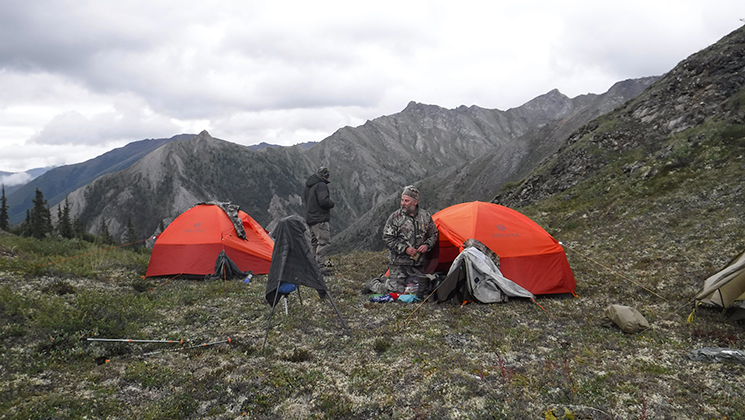
Gold Mine
Dave Leonard’s wife, Sue, is Australian. I met him on a buffalo hunt in northern Australia ages ago, and did several hunts with his Mountain Monarchs outfit when he was based out of Kotzebue, Alaska. Experienced and dedicated, he’s among the best I’ve hunted with—and also a lot of fun. A cowboy poet by hobby, he can recite Robert Service by the hour, and he knows Alaska. In recent years he relocated to the central Brooks, dividing his time between there and his brown bear area on the Alaska Peninsula.
So, on a rainy day in early August I flew from Fairbanks to Bettles. We ran over to his house, aka “The Ram Hole,” checked gear, whisked outside town and checked the rifle, and in a couple of hours were in his Hershey-chocolate-colored Super Cub, headed north into the Brooks. Funny thing about Dave Leonard: He always has good friends, and I’m proud to be among them. We flew north out of Bettles, took a right turn up Gold Creek then headed for a long dirt strip in a broad valley. There a buddy of Dave’s has a gold-mining operation in the middle of nowhere, with snug cabins as an operating base for grizzly hunts and a base camp for sheep.
On the way in Dave pointed out the mountains we’d be hunting. He figured a seven- or eight-hour climb to set up spike camp, kind of a nothing as sheep hunting goes. From the air the mountains didn’t look too bad, but I knew they’d be a lot worse on the ground.
Jordan and Dillon were already there, catching grayling. Dave got back in the air quickly and returned to Bettles for David Dressler, hoping to drop him elsewhere so he could hunt sheep solo. The planned landing site wasn’t safe, so David hunted with us then carried on. (After I departed he took a fine ram!) That first night we slept on real beds, and headed out at 8 a.m., down the creek a couple miles … and then up.
From the creek it was all uphill, mostly medium-steep, a lot of it the awful muskeg footing. Bolstered by walking poles and knee braces, I was slow, but I’d been training as hard as creaky knees allow, and I did better than I expected. By early afternoon we were setting up tents, and then we made a quick run up the ridge. Our high green saddle was empty, but there were ewes and lambs on the mountain beyond, drifting in and out of low clouds. We watched them for a couple of hours then repaired to the tents to see what Mountain House had in store.
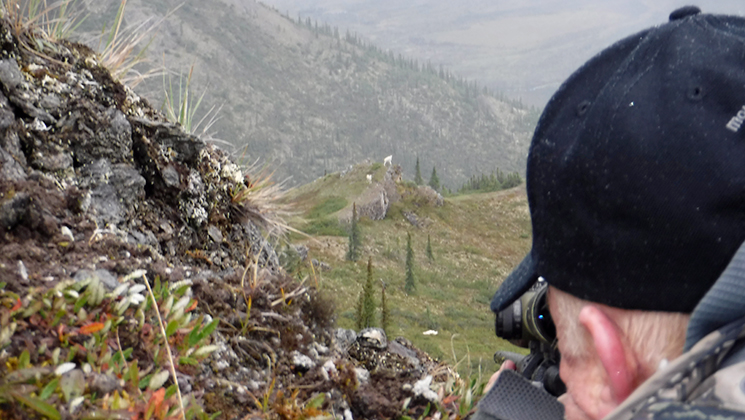
Raindrops Keep Falling …
It rained most of the next day. That was actually a blessing: It had been dry and the nearest creek was a long way down. We collected rainwater—and never had to drop down to fetch water. The low clouds that came with the rain were a problem. You can’t hunt sheep if you can’t see. Dave called Bettles on the sat-phone for a weather report and it was grim: Gale-force winds were coming, bringing blizzard conditions to the central Brooks. We weren’t seeing it where we were; it was fairly calm, with a steady rain from drifting clouds. Above us it was socked in, but the valley below was clear. I was seeing a repeat of 2015, while Dave was envisioning his beloved Super Cub upside down at the mine. Figuring if it really got bad we were a three-hour run to the mine, Dave gathered his gear and headed down the mountain. Later in the day we heard the plane start up then saw it winging south toward Bettles, where secure tie-downs awaited.
There wasn’t much we could glass, so we spent our time watching for the storm, which never reached us. It pounded the north slope, but we were south of the divide and all we got was rain. Next morning the clouds were higher, and that afternoon we made our run on those three rams.
Northern sheep hunting puts you into an odd schedule. Sheep are most active in the evening so, with half-light until midnight, it isn’t unusual to get back to camp very late. Dawn comes soon, but you can’t hunt ’round the clock, so we slept while the rain returned and the clouds dropped. Most of the next two days we read what books we had, and I made a game of lying on my back, watching water droplets form and gobble up each other as they ran down the tent.
When it cleared a bit we saw ewes and lambs in the saddle, an obvious movement corridor. On a rainy day with moderate visibility we hiked up above the far side and glassed for several hours. Up higher it was cold as well as wet, and nothing was moving. These things run together, but for sure it was the evening of the sixth day when we returned to our tents and instantly spotted sheep up to the right, across a deep bowl on a long, descending ridge.
One ram, two rams then the third came onto the skyline and stood for a long time. They were our same three rams; this last was the big one and he still looked good. At some point, perhaps while we were sleeping or were blocked by clouds, they’d crossed to this side. It was too late to make a move, but if they stayed on that ridge overnight we’d be in good shape.
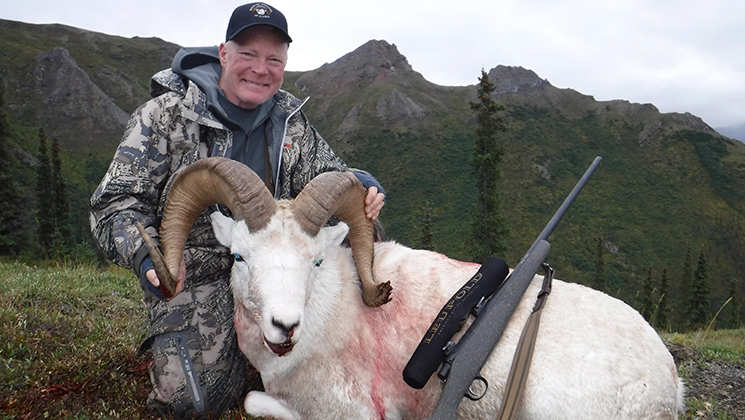
A Plan Comes Together
In the morning they were still there, a bit lower, perhaps wondering about the orange bubbles of our tents far below. We slipped out of camp the other way; it would take several hours to get to them, so we went carefully, figuring that if they took their seemingly customary route toward the saddle we’d meet them head-on. If they stayed put we’d circle the whole mountain and come in on the far side of their ridge.
They stayed, but we didn’t know that until we got around to their side. Low clouds were coming and going, and the sheep were in a great spot … if only we kept enough visibility. Leaving Dillon and David on the rim, Jordan and I started down—and quickly got stuck when the rams fed from one side of the ridge to the other. This time the clouds were our friends. We huddled in some scrub alder until a big, fluffy cloud came in then hustled over the top.
When it cleared we realized we were too high on the ridge and still in view so we froze again. Another friendly cloud came in, and we scrambled downhill then started moving laterally along the ridge. At this point the rams were about 600 yards away, but there was no need for discussion: We had them, and we could get much closer. Funny, my knees weren’t hurting, and my legs and lungs were just fine.
Now the sheep were hidden behind the ridge, and we’d marked them in a little pocket below descending rocky points. We cut the distance in half, crept to a little point and peered over. The smallest ram was visible; the others must be there. I was okay to set up for a shot, but the wind was good and sheep can’t see through rocks. A hundred yards down to the next point and Jordan peeked around while I chambered a round.
Ducking back slowly, he said, “They’re coming toward us, not 150 yards.”
Jordan moved out of my way and I crawled into position, prone against the base of the rock. The rams were angling toward us; in minutes it could be a perfect bow shot, but right now it was good enough. The biggest ram was third again: 120 yards.
He took the first shot hard but started to run. We wanted him there, not over the ridge, so I shot again and he went down. The other rams waited for him a long time then moved on up the ridge.
We had work to do, but there was no rush. Our orange bubbles were in view, and the day was young. We took our time, savoring what might be my last North American ram … or perhaps not.
